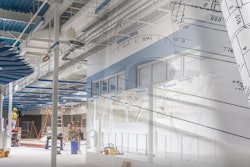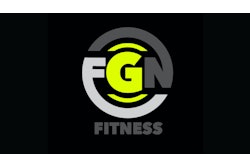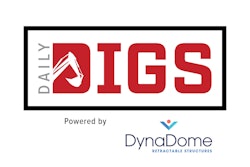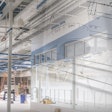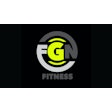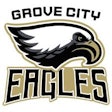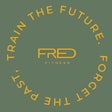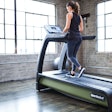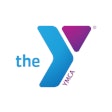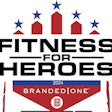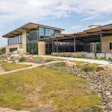![[Image courtesy of American Platforms]](https://img.athleticbusiness.com/files/base/abmedia/all/image/2019/05/ab.TurfFit519_feat.png?auto=format%2Ccompress&q=70&w=400)
Tyron Woodley's road to redemption will be paved with synthetic turf.
After defending his Ultimate Fighting Championship welterweight belt four times, Woodley in March lost a bout for the first time since 2014.
"The Chosen One," as Woodley is known, will plot his comeback on his training surface of choice — Combat Turf™, a bright red carpet featuring black inlaid markings that covers the floor in his St. Louis gym wall to wall.
"He's got it set up where he can push a sled down a sprint lane, and then he's got agility ladders and dots built into the turf, because everything about UFC and combat sports is you want to be fast on your feet," says Matt Riggs, business director at Sporturf, which markets Combat Turf. "He really utilizes the turf to make himself faster."
Woodley is not alone. Elite athletes and recreation enthusiasts alike are turning to turf to enhance their workout experience, and an increasing number of facility operators are seizing on the trend by dedicating at least some square footage to synthetic turf, even if it means replacing existing wood or rubber flooring.
"The fastest-growing segment of our business is what we call speed and agility training turf," Riggs says. "Gone are the days of three sets of bench and squats. Athletes still want to do that type of work, but then come to the center of their space and push a sled or flip a tire or do plyometric work."
Though an increasing number of athletes in outdoor ball sports are accustomed to competing on synthetic turf, training turf is different in that it lacks any sort of infill. "Our product is a completely non-infill system, which keeps the indoor facility owners happy because you don't have the messy infill getting spilled over into areas where their expensive weight equipment is," Riggs says. "They like the clean look, the low profile."
There are some variables involved when specifying training turf, however. Here are four key considerations:
![[Photo courtesy of Sporturf]](https://img.athleticbusiness.com/files/base/abmedia/all/image/2019/05/ab.TurfFit519a.png?auto=format%2Ccompress&fit=max&q=70&w=400) [Photo courtesy of Sporturf]
[Photo courtesy of Sporturf]
Space requirements
Activities the turf will accommodate, as well as its potential user population, should dictate ideal dimensions. According to Jet Thompson of sports flooring manufacturer PLAE, 15 by 60 feet is the minimum space one should allocate to fully take advantage of all turf has to offer.
"Sixty feet so you can sprint down and back, you can push a sled down and back, you can do intervals — go down 15 feet, come back, 30 feet, 45 feet — to make it worth the while," Thompson says. "Fifteen feet not only is the width that the turf comes in, but it gives you a wide enough area that you can have four or five people go at one time. Now, if you have a smaller population, you may only need seven feet wide where maybe two or three people would go at one time."
Turf can blanket entire rooms, such as a racquetball court converted to functional fitness, or it can serve as its own dedicated space. "We glue it down to the concrete and put a very small transition strip around it just to prevent a trip hazard. It creates a very clean look," Riggs says. "Turf butts up really nicely next to some of the lower-profile rubber mats, as well."
Fiber and pad specs
Polyethylene fiber is the popular choice over more abrasive nylon (though some turfs may employ a combination), and a minimum face weight of 40 ounces is recommended — the weight of turf employing Sporturf's 3/4-inch fiber option, for example. The company also offers pile heights of 7/8 of an inch and 11/8, which both carry a weight of 55 ounces. The 3/4-inch option is Sporturf's most popular based on its price point and the fact it comes in the most color varieties.
PLAE offers only 3/4-inch pile, but in a turf featuring a denser fiber count and weighing 48 ounces.
One of the reasons turf has become a go-to exercise surface is the forgiveness it affords users performing planks, pushups, sit-ups, burpees or bear crawls. Taller fibers enhance that feel even further. "If you're doing a lot more skin-to-turf interaction, the longer pile gives you a lot more of the soft polyethylene fibers that will lay over and cover the texturized nylon thatch," Riggs says. "It's a little bit more skin-friendly."
"People feel it's a little more comfortable to get on turf than it would be on a rubber surface," Thompson says. "One, it actually feels better, but two, in your mind it just looks more inviting to get on a piece of turf than it does to get on a black piece of recycled rubber."
"It's vibrant, it's bright, so they're just drawn to that area," adds Shawna Healy, vice president of business development at PLAE, of turf users. "If they're going to be doing a bear crawl, I think they'd much rather do that on something that mimics what they might be using outside."
Also aiding in user comfort is an industry standard 5-millimeter foam backing, though 3- and 8-millimeter options also are available from Sporturf. "It's a firm feel underfoot," Riggs says. "That 5-millimeter foam pad is going to give you enough cushion, but it's not going to be so soft that you're going to get a lot of ankle play. You don't want it to be too soft."
![[Photo courtesy of PLAE]](https://img.athleticbusiness.com/files/base/abmedia/all/image/2019/05/ab.TurfFit519b.png?auto=format%2Ccompress&fit=max&q=70&w=400) [Photo courtesy of PLAE]
[Photo courtesy of PLAE]
Customized markings
Functional training spaces of all kinds often feature permanent markings for various activities within the flooring itself, and turf areas are no different. "We're able to inlay into the turf the speed ladders that would typically be laying on top of a rubber floor, so it's no longer a trip hazard," Riggs says. "Same with speed dots."
Moreover, the same water-jet cutting technology used to create ladders, dots, yard lines and hash marks can produce detailed logos. "One thing that we pride ourselves on is the type of logos we can provide, because that's really what sets a lot of these facilities apart," Thompson says. "It's another reason so many of these facilities want to put the turf areas in — just to highlight their brand and use it on social media or in their fitness center marketing campaigns. This gives them an easy way to do that."
![[Photo courtesy of Bfitgyms]](https://img.athleticbusiness.com/files/base/abmedia/all/image/2019/05/ab.TurfFit519c.png?auto=format%2Ccompress&fit=max&q=70&w=400) [Photo courtesy of Bfitgyms]
[Photo courtesy of Bfitgyms]
Upkeep
Training turf may look plush and inviting, but it still gets sweat upon just like any other workout surface, and facility operators need to treat and clean it regularly. "Just like they would on a rubber surface, they need to come up with a maintenance schedule," Thompson says. "That's a part that a lot of people overlook. They have to make sure that they maintain their turf."
Thompson recommends using a spray-bottle antimicrobial to treat the turf once a week, and Healy adds that blowers and even vacuums can be used to clean the surface, so long as the vacuum doesn't employ a roller.
Is synthetic turf so rooted in the indoor training market that it would be unthinkable to build a facility without it? Not quite, according to Riggs, but it's gaining ground on traditional workout surfaces — and fast.
"I wouldn't go so far as to say every new facility is going to have something like this," he says. "Not everybody has the budget for it. It's an expensive piece of what I would call equipment for a gym. But I would say more often than not they want it, whether they can afford it or not."
And once it's specified, facility operators usually have only one regret. "At first, they're probably apprehensive of taking up so much of the weight room floor," Healy says. "Then, once it's down and they see the amount of use and the different functions, they realize, 'I wish I had more turf.' "
This article originally appeared in the May 2019 issue of Athletic Business with the title "Turf: gaining ground within indoor training areas." Athletic Business is a free magazine for professionals in the athletic, fitness and recreation industry. Click here to subscribe.



















